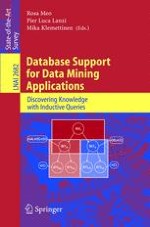Data mining from traditional relational databases as well as from non-traditional ones such as semi-structured data, Web data, and scientific databases housing biological, linguistic, and sensor data has recently become a popular way of discovering hidden knowledge.
This book on database support for data mining is developed to approaches exploiting the available database technology, declarative data mining, intelligent querying, and associated issues, such as optimization, indexing, query processing, languages, and constraints. Attention is also paid to the solution of data preprocessing problems, such as data cleaning, discretization, and sampling.
The 16 reviewed full papers presented were carefully selected from various workshops and conferences to provide complete and competent coverage of the core issues. Some papers were developed within an EC funded project on discovering knowledge with inductive queries.
